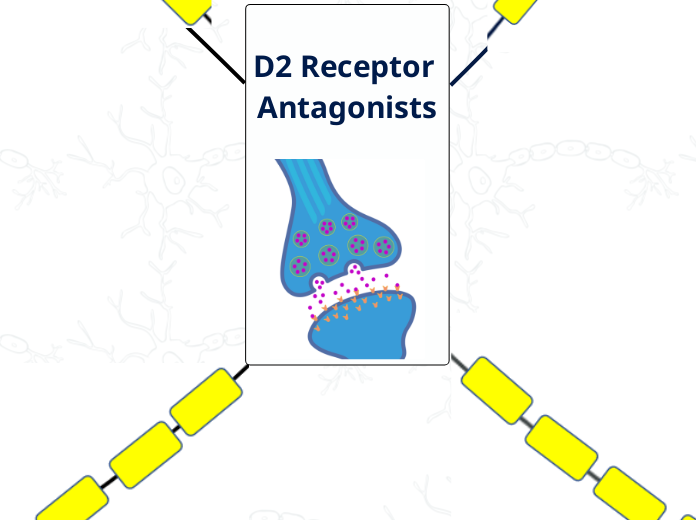przez Ellen Murphy 2 lat temu
183
D2 Receptor Antagonists

przez Ellen Murphy 2 lat temu
183

Więcej takich
Dose reduction
Aromatic hydroxylation
N-dealkylation
Dual mechanism of action
Domperidone acts as an antagonist at the dopamine D2 receptors in the CTZ.
By inhibiting agonist activity in the CTZ it will not VC.
Decreases excitatory input in vomiting centre
Decreases sensitivity to noxious stimuli
Gastrokinetic
Domperidone-N-oxyde
Nausea and vomiting induced by
Migraine
Drugs
Medications to treat Parkinson's disease
Conditions
Cystic fibrosis
PF3012
Post-operative
Chemotherapy
Pharmacist only supply
PF1011
Monitoring
QT interval prolongation
Relief of nausea and vomiting only
No longer used for bloating or heartburn
Maximum of one week
Counselling points
Oral suspension 1mg/ml
Oro-dispersible tablet
Film coated tablet
Metoclopramide works as a Muscarinic Acetyl Choline Receptor Agonist which is capable of causing a number of side effects;
These side effects are usually well tolerated because this agonism is a minor part of the overall pharmacology.
CTZ
Decreases excitatory input in vomiting center
Decreases sensitivity to noxious stimuli
Peripherally
Increases the release of acetyl choline
increases gastric emptying
Side effect: Diarrhea
Stimulates smooth Muscle contraction
Adjunct to Analgesia
Migraine Induced Nausea and Vomiting
Gastroparesis
PF3009
GORD
Opioid Substitution Treatment N+V
Prophylactic Post Operative N+V
Post Radiotherapy N+V
Delayed Chemotherapy N+V
Demethylation
Major route of metabolism
Nor-metoclopramide
Conjugation
Oxidation
Metoclopramide Counselling:
Oral Tablets 5mg and 10mg
Nor-Metoclopramide
Counselling
Counselling
Drowsiness – Take before bed, do not drive or operate machinery, be aware when drinking alcohol.
Hyperprolactinaemia
EPSEs
Negative Symptoms
Positive Symptoms
The influence of renal impairment on the pharmacokinetics of haloperidol has not been evaluated. No dose adjustment is recommended, but caution is advised when treating patients with renal impairment. However, patients with severe renal impairment may require a lower initial dose, with further doses administered and adjusted according to the patient’s response
The influence of hepatic impairment on the pharmacokinetics of haloperidol has not been evaluated. Since haloperidol is extensively metabolised in the liver, it is recommended to halve the initial dose.
The recommended initial haloperidol dose in elderly patients is half the lowest adult dose. Further doses may be administered and adjusted according to the patient’s response. Careful and gradual dose uptitration in elderly patients is recommended.
Monitoring:
Electrolyte disturbances such as hypokalaemia and hypomagnesaemia increase the risk for ventricular arrhythmias and must be corrected before treatment with haloperidol is started. Therefore, baseline and periodic electrolyte monitoring is recommended
Counselling:
Switch from mania to depression: There is a risk in the treatment of manic episodes of bipolar disorder for patients to switch from mania to depression. Monitoring of patients for the switch to a depressive episode with the accompanying risks such as suicidal behaviour is important in order to intervene when such switches occur.
Monitoring:
A baseline ECG is recommended before intramuscular dosing. During therapy, the need for ECG monitoring for QTc interval prolongation and for ventricular arrhythmias must be assessed in all patients, but continuous ECG monitoring is recommended for repeated intramuscular doses. ECG monitoring is recommended up to 6 hours after administration of haloperidol solution for injection to patients for prophylaxis or treatment of postoperative nausea and vomiting. Whilst on therapy, it is recommended to reduce the dose if QTc is prolonged, but haloperidol must be discontinued if the QTc exceeds 500 ms.
PF3010
Greater risk of QT prolongation with use of IM depot injectable dosage forms of haloperidol.
Counselling:
Oral solution and suspensions need to be shaken before use.